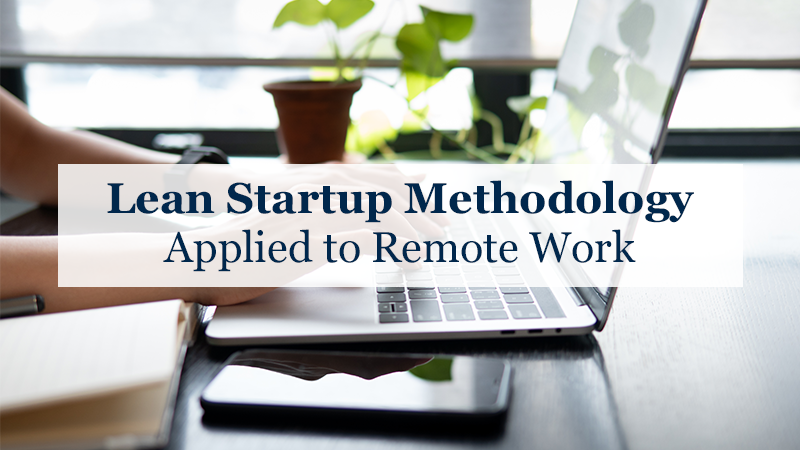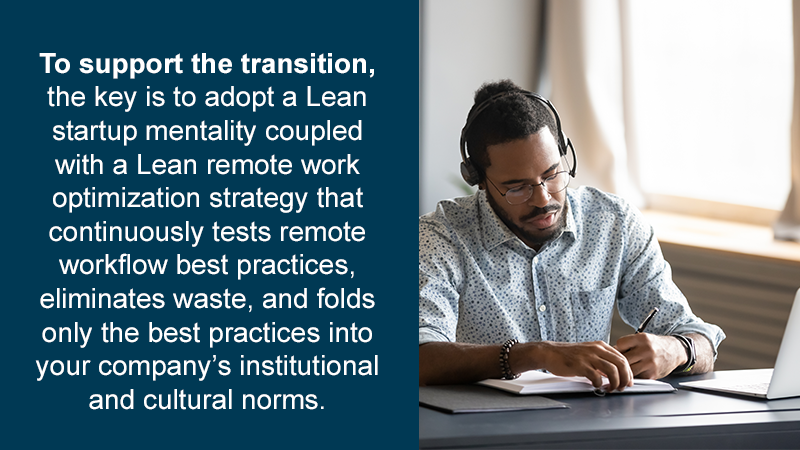Lean Startup Methodology Applied to Remote Work

With the recent pandemic forcing more companies to shift to an increasingly more remote work model, companies are discovering that they don’t know who their employees truly are yet or how their work should be done remotely. Make sure you’re online during business hours you’re told. Ok, so cover your um, bases, you think. Don’t let that green light in Skype or Microsoft Teams change to any other color but red. Red means you’re SUPER busy. Green means you’re busy – maybe, maybe not. Available? In theory, yes. But you could have trained the retired old lady next door to refresh that green light all afternoon while you snuck out for a round of golf.
The response to the uncertainty has been a flood of remote work best practices, but with so many experts, who or what to follow? The only certainty – the office is aging and can no longer be the Superdome where all the games are played. Even on-site ping pong is no longer trendy.
To support the transition, the key is to adopt a Lean startup mentality coupled with a Lean remote work optimization strategy that continuously tests remote workflow best practices, eliminates waste, and folds only the best practices into your company’s institutional and cultural norms.
Paradigm Shift – A Lean Remote Startup Mentality
Borrowing from the book, The Lean Startup by Eric Ries: “a startup is a human institution designed to create new products and services under conditions of extreme uncertainty.” In this case, the human institution or startup would be your team, department, or whole company developing goods and services under the guise of a new uncertain remote work environment requiring new inherent rules of engagement. More than just a name, startup implies an agile entrepreneurial mentality in which ideas are constantly battle tested and evaluated. Being able to pivot is essential and required to mitigate risk, transition quickly, and crush it.
With new rules of engagement comes the responsibility of mastery. Lean is derived from the manufacturing principals and methodologies Toyota is most prominently credited for during the 1930s for identifying and reducing waste, streamlining processes, and adding value. Keeping it simple yet intentional, adopting a Lean Build-Measure-Learn methodology, will provide the backbone for kaizen, Japanese word for continuous improvement, and thus the discipline needed for mastery.
Putting it all together, the Lean Remote Startup is the agile mindset, the principals, from which a Lean Build-Measure-Learn methodology is specifically and strategically applied to a remote work environment. Dubbed the Lean Remote Work Optimization methodology moving forward, the goal is continuous improvement for how remote work is done — exchanging waste, redundancy, risk, and uncertainty for optimized value, peak performance, and a thriving work culture.

The Six Components for Lean Remote Work Optimization
Remote work is here to stay and grow dramatically. A recent Gartner survey of top CFOs found that 3/4 of their companies planned to increase remote work permanently. The response is positive as more people want to work from home, a Gallup survey found that 60% of the workforce are open to remote working. Within the next decade it’s estimated up to 30% of the workforce could be working from home.
The shift is on, turning the workday routines, environment, and workflow processes on their head. Getting up and going to the office is as easy as sitting up in bed and opening your laptop. The daily commute is different now, no traffic, just frequent drive-bys the fridge. Check your waistline. Need a quick team huddle in your office, the dog is happy to sit in your lap, there’s no coworker in sight. It’s just you, your laptop, the gardener blowing leaves outside your office window, and a million other distractions.
Time to get organized and get a couple “don’ts” out of the way first. Don’t start piecemealing a bunch of “best practices” and don’t reduce your remote work model to a policy. This is not a one-time remodel that you live in until the walls fall down, it should be a remote work program that relies on a Lean Remote Work Optimization methodology that will continuously cycle through, incrementally improving each time. Think of it as your dream home, being built from the ground up…with a never-ending honey-do list to keep your home in order.
Your Lean Remote Startup is a living system that should align with your overarching company values and goals and eventually just feel like this is how you do your best work. Looking under the hood, six components make the engine go. Understanding the role and inter-dependency of each, will keep you organized and help clarify when, where, and how changes need to be made. The six components for Lean Remote Work Optimization are:
- Structural Policies
- Behavioral Norms
- Cultural Continuity
- Employee Wellness
- Tech Tools
- Performance Metrics
Each component requires continuous Lean Remote Work Optimization – cycling through best practices and remote work strategies with rigor and continuous improvement intent.
Final Thoughts
As companies continue to grow and scale remote work models, their ability to control and influence productivity and corporate culture will compete more and more with the home and employee autonomy. The result will be an emphasis on corporations not only trying to keep their employees productive and accountable but also engaged, connected, balanced, and highly satisfied. In subsequent blogs, I will expound upon the components outlined above in greater detail. More importantly, I will discuss how your organization can go about applying each to leverage all the benefits of a remote work structure while mitigating the potential pitfalls.
Aaron Williamson, Senior Consultant